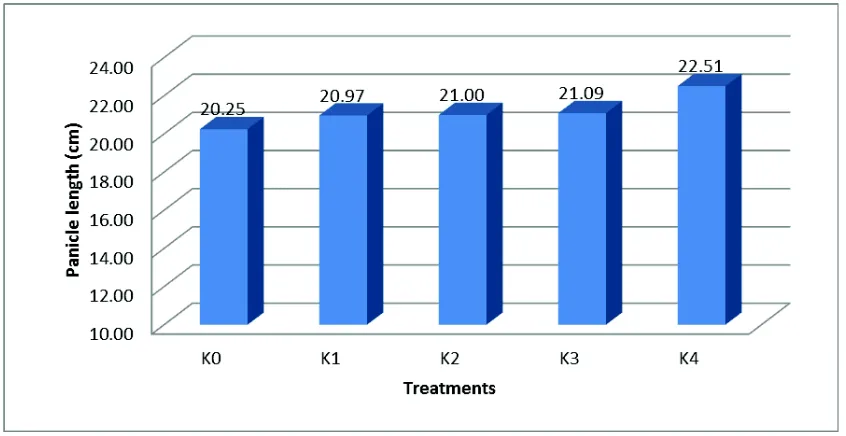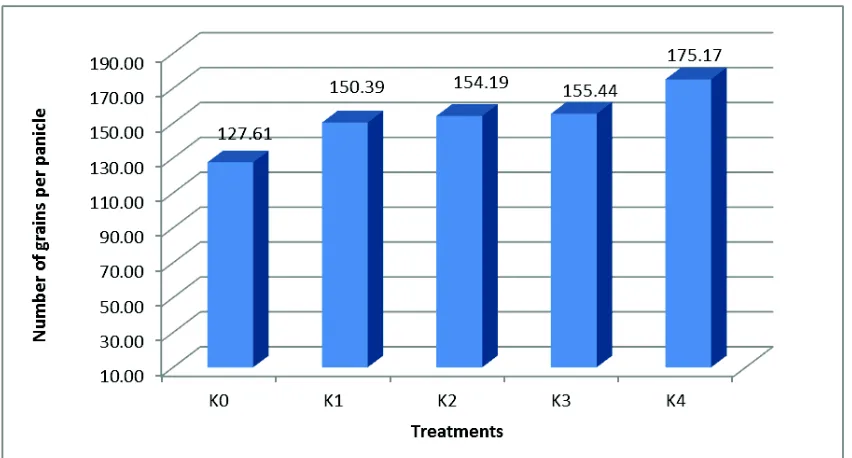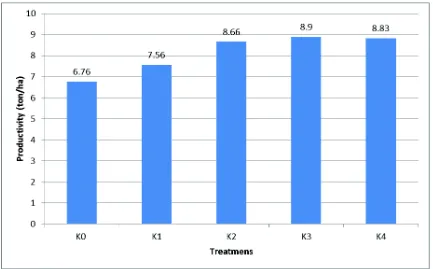1
The 16th FOOD INNOVATION ASIA CONFERENCE 2014
12 -13 June 2014, BITEC Bangna, Bangkok, Thailand
Optimization of Legowo Row Cropping System In Rice Paddy Cultivation
Sumiyati1*, I Wayan Tika1, Wayan Windia2, Ni Nyoman Sulastri1, I Putu Gede Budisanjaya1
1Departement of Agricultural Engineering, Faculty of Agricultural Technology,
Udayana University, Bali, Indonesia.
2Departement of Agribusiness, Faculty of Agriculture, Udayana University, Bali, Indonesia.
* Corresponding author: [email protected], [email protected]
Abstract
One of the factors that affect s plant growth is spacing. Plant spacing distance affects the
microclimate condition and at the end will influence plant growth and productivity of rice paddy.
The purpose of this study is to obtain optimal spacing distance of row cropping system (Legowo)
in order to improve rice productivity in subak system. The study was conducted in Subak Suala,
Pitera village, Penebel distric, Tabanan Regency, Bali, Indonesia. The study consisted of 5
treatments of spacing distance width, namely: K0 (Control, spacing distance based on local
farmer practices = 28 cm), K1 (Legowo width of 1.25 x row spacing = 35 cm), K2 (Legowo
width of 1.50 x row spacing = 42 cm), K3 (Legowo width of 1.75 x row spacing = 49 cm), and
K4 (Legowo width of 2.0 x row spacing = 56 cm). Every treatment was repeated 3 times, thus
there were 15 demonstration plots. The observation variables in the study included: panicle
length, number of grains per panicle, weight of grains per clumb, weight of 100 grains, the
productivity per area unit. The result was obtained were an increase in panicle length, number of
grains per panicle, and weight of 100 grains. K3 treatment showed a higher production compared
to other treatments.
Keywords: Rice cultivation, Legowo row cropping system, Productivity
Introduction
Rice is the staple crop for most Asian countries. In Indonesia, rice is generally cultivated
2
The 16th FOOD INNOVATION ASIA CONFERENCE 2014
12 -13 June 2014, BITEC Bangna, Bangkok, Thailand
irrigation system. Subak is a farmer organization which manages water irrigation in a rice field,
get water supply from a certain source, manages at least one subak temple, and self governing
association. Subak is listed as a world cultural heritage site.
One of the factors that affect plant growth is spacing. Plant spacing distance affects the
microclimate condition and at the end will influence plant growth and productivity of rice paddy.
This is because the micro-climatic conditions affect several important rice physiological
processes such as stomata aperture, transpiration rate, water and nutrients absorption rate,
photosynthesis, and respiration.
Some cultivated area with Subak Irrigation Systems in Bali have already implemented
legowo row planting system. Legowo row planting system is plant population arrangement
techniques in a particular unit of area, where among several groups of rows there will be an
empty wider elongated row and it is parallel to the rows of rice plants (Abdulrachman, 2012).
Those arrangements are expected to improve the suitability of micro-climatic conditions that
favor plant growth. Microclimates are in the form of climate variations on a small scope (Brooks,
1988). Appropriate microclimate conditions are intended to improve the productivity of rice
plants. With increased productivity, it will support the sustainability, especially in the field of
food. Bouma (2005) argued that the speed of growth and development of plants and crops, and of
pests, is strongly influenced by meteorological parameters.
The purpose of this study was to obtain optimal spacing distance of row cropping system
(Legowo) in order to improve rice productivity in subak system. Legowo system is
manipulating plant location, therefore as if plant is placed into a plant side more. Commonly
plant which is planted at the edge will result in high production and grain quality. This is
because the edge plant will get more sunlight. There are several types of Legowo row cropping
system. For example Legowo 6:1 is row cropping system which every six blank rows
3
The 16th FOOD INNOVATION ASIA CONFERENCE 2014
12 -13 June 2014, BITEC Bangna, Bangkok, Thailand
Materials and Methods.
The study was conducted in Subak Suala, Pitera village, Penebel distric, Tabanan Regency, Bali,
Indonesia. Some instruments were used in this study are: measuring tape, hoe, hand tractor with
rotary plow, sickle, planting line maker tool, weeding tool, sprayer, scales, rope, scissors,
stationary, and harvesting tools. Materials were used include: Cigeulis rice seeds, fertilizer
(UREA and PONSKA (N, P2O5, K2O,S) (Anonymous, 2005)), and irrigation water. The first
dose of fertilizer was applied at the age of 20 days after transplanted ie 2 kg urea per acre and
Ponska 1 kg per acre. The second dose of fertilizer was applied at the age of 35 days after
transplanted ie 1 kg of urea per acre and Ponska 0.5 kg per acre.
The study consisted of 5 treatments of spacing distance width, namely: K0 (Control,
spacing distance based on local farmers practices = 28 cm), K1 (Legowo width of 1.25 x row
spacing = 35 cm), K2 (Legowo width of 1.50 x row spacing = 42 cm), K3 (Legowo width of
1.75 x row spacing = 49 cm), and K4 (Legowo width of 2.0 x row spacing = 56 cm). Every
treatment was repeated 3 times, thus there were 15 demonstration plots.
The observation variables in the study include: panicle length, number of grains per
panicle, weight of grains per clumb, weight of 100 grains, the productivity per area unit.
Research Implementation
Land preparation was divided into two stages, there were soil tillage and designing the
demonstration plot. Soil tillage stage included: gutters cleaning, repairing the rice field, plowing
using a hand tractor, rotary type, soil tillage using hoe for land that cannot be reached by tractor.
After those all, soil harrowing will be performed. 15 demonstration plots were designed
4
The 16th FOOD INNOVATION ASIA CONFERENCE 2014
12 -13 June 2014, BITEC Bangna, Bangkok, Thailand
Good Cigeulis rice paddy seeds were soaked about 2 days in order to stimulate the
germination process. When all seed started germinating, the seeds were ready to be placed in the
seedling place for 18 days.
The initial stage of transplantation is make line of plant row use specialized tool called
“caplak”. This stage was done a few hours prior seed transplantation was performed, so the lines
are clearly visible for planting. The 18 days-seedling were transplanted based on planting
spacing distance and legowo distance based on predefined treatment.
Weeding was done manually by hand and mechanically using a hedgehog. Pest control
was done by spraying insecticides. Harvesting was done when the rice paddy was 105 days after
planting.
Data collection
Samples were taken for productivity on a five-point diagonally on the demonstration
plots. Panicle length is measured from the base to the tip of the panicle. Number of grains per
panicle was calculated by separating the grain from the panicle first. Weight of grains per clump
was measured by weighing the grain produced on each sample clump. Weight of 100 grains
calculated with 100 grain separated and then weighed. Productivity per area unit was conducted
by sampling a few clumps at the time of harvest. To calculate production per plot using the
formula:
weight of grain per clump (kg)
Data Analysis
ANOVA test performed on each parameter. If the result gives a P value of <0.05, the
5
The 16th FOOD INNOVATION ASIA CONFERENCE 2014
12 -13 June 2014, BITEC Bangna, Bangkok, Thailand
Results
Observed plant productivity parameters in this study were panicle length, number of
grains per panicle, weight of grains per clumb, weight of 100 grains, the productivity per area
unit.
6
The 16th FOOD INNOVATION ASIA CONFERENCE 2014
12 -13 June 2014, BITEC Bangna, Bangkok, Thailand
Figure 2. Average of number of grains per panicle in each treatment
7
The 16th FOOD INNOVATION ASIA CONFERENCE 2014
12 -13 June 2014, BITEC Bangna, Bangkok, Thailand
Figure 4. Average of weight of 100 grains in each treatment
8
The 16th FOOD INNOVATION ASIA CONFERENCE 2014
12 -13 June 2014, BITEC Bangna, Bangkok, Thailand
Discussion
Results indicated the wider legowo width, the panicle length of rice paddy was longer.
This was because as the legowo distance was wider, the plant got some beneficial factors which
supported its optimal growth. ANOVA test based on panicle length gives P value < 0.05, which
means that the difference in treatment of legowo width have significant effect on panicle length.
The length of panicle was significantly related to the number of grain per panicle. When
the length of panicle was longer, in most cases, the number of grain per panicle would be more.
As the wider of legowo width was, the more microclimates inputs were received by plant which
increased stomata aperture, transpiration rate, water and nutrition absorption rate, photosynthesis
and respiration. In order for the photosynthetic reaction to occur, light must be available and
impinging on the leaves and/or other photosynthetically active organs of the plant. Solar
radiation supplies the energy required in the process (Rosenberg, et all, 1983).
The length of panicle can be classified into 3 (three) classes, there are short panicle (20
cm length), medium panicle (20-30 cm length) and long panicle (more than 30 cm length). In this
study, the length of panicle was in the range of 20.25 cm - 22.51 cm. The length of panicle
increased as the width of legowo wider (Figure 1).
The number of grain per panicle was significantly related with the length of panicle. The
longer panicle’s length, the more grains were produced per panicle. This study indicated that the
wider legowo width; number of grains per panicle was greater (Figure 2). It was also indicated
that the wider of legowo width was, the more the number of tiller would be besides the length of
panicle and total grain per panicle. Therefore, weight per clumps would be increasing as the
legowo’s width was wider (Figure 3). ANOVA test based on number of grain per panicle and
weight per clumps give P value < 0.05, which means that the difference in treatment of legowo
width have significant effect on number of grain per panicle and weight per clumps also.
When the legowo’s width was wider, plant would be supplied better micro-climatic
9
The 16th FOOD INNOVATION ASIA CONFERENCE 2014
12 -13 June 2014, BITEC Bangna, Bangkok, Thailand
This condition would increase weight of 100 grains as the width of legowo was wider (Figure 4).
ANOVA test based on weight of 100 grains gives P value < 0.05, which means that the
difference in treatment of legowo width have significant effect weight of 100 grains. At
saturation light intensities and normal CO2 concentration, photosynthesis is affected by
temperature because biochemical processes are limiting (Chang, 2009).
K3 treatment showed a higher production compared to other treatments since the plant
growth effectiveness was better. Although for K3 the effectiveness of plant growth was better,
the total number of clumps per area unit was fewer. Weight of grain per clumps for K4 was
higher compared to K3, even though the number of plant was fewer, so the productivity per area
unit was less than K3 (Figure 5). K3 (Legowo width of 1.75 x row spacing = 49 cm) resulted in
the highest productivity per area unit with the total production 8.90 ton/ha.
Conclusion.
The wider legowo width increased the length of panicle, number of grains per panicle and
weight per 100 grains. The highest productivity was shown in K3 ((Legowo width of 1.75 x row
spacing = 49 cm) with its production of 8.90 ton/ha.
References
Abdulrachman, S. 2012. Sistem Tanam LEGOWO. Indonesian Agency for Agricultural
Research and Development Ministry of Agriculture Republic of Indonesia. Bali.
Anonymous, 2005. Fertilizer use by crop in Indonesia. Food and Agriculture Organization of the
United Nations. Rome.
Brooks R. G. 1988. Site Planning (Environment, Process, and Development). Prentice-Hall Inc.
10
The 16th FOOD INNOVATION ASIA CONFERENCE 2014
12 -13 June 2014, BITEC Bangna, Bangkok, Thailand
Bouma, E. 2005 Development of comparable agro-climatic zones for the international exchange
of data on the efficacy and crop safety of plant protection products. Bulletin
OEPP/EPPO, Bulletin 35, 233–238. John Wiley & Sons, Inc.
Chang, Jen Hu. 2009. Climate and Agriculture: An Ecological Survey. Aldine Transaction.
Canada
Rosenberg, N.J., Blaine L. Blad, Shashi B. Verma, 1983, Microclimate, The Biological


